From Tarkovsky to AI: On the Evolving Resonance of Solaris

Throughout the past half century, Stanisław Lem’s novel Solaris (1961) has persisted as a productive ground for artists and filmmakers re-examining memory, identity, and the limits of human understanding. Deimantas Narkevičius’ Revisiting Solaris (2007) engaged this legacy not by adding to the list of existing cinematic adaptations of the book but by probing the gaps and the links between literature, cinema, and visual art. Through this film, Narkevičius critically reflects on both the cultural and political history Lem’s novel was situated in, as well as the potentials and limits of cinema vis-a-vis other arts, while simultaneously challenging existing boundaries between them.
In this conversation, which took place after Revisiting Solaris was installed at the 14th Shanghai Biennale in 2023 – an exhibition I co-curated – Narkevičius reflects on why Lem’s Solaris is still worth ‘revisiting’ today, as concerns about technologically simulated realities have only intensified. Narkevičius’ use of M. K. Čiurlionis’ early twentieth-century photographs to evoke the ocean on Solaris underscores his film’s conceptual interplay between situated collective memory and individual perception, making his film equally responsive to the past, the present and the future. Revisiting Solaris, as Narkevičius’ answers to my questions confirm, is not only an intellectually stimulating and highly intertextual moving-image work, but also a lens through which we can continue to interrogate our constantly shifting realities.
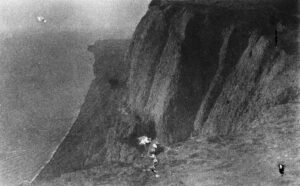
Mountains and the sea, 1905, photograph by M. K. Čiurlionis
Lukas Brasiskis: While working on the Solaristics Room for the recent Shanghai Biennale, I found it surprising that the story of the planet Solaris continues to feel so timely. From Stanisław Lem’s original novel to its Soviet, American, and Japanese film adaptations, and through its various reinterpretations by contemporary artists, it continues triggering discussions on memory, identity, and time. It is almost as if Solaris never stops being relevant, with each return offering fresh insights … I am curious about what initially compelled you to revisit Solaris in the 2000s and whether you feel that Lem’s story resonates differently today, in 2024, compared to when you made he film in 2007?
Deimantas Narkevičius: In each decade, we read Stanisław Lem’s book differently, and we probably see Andrei Tarkovsky’s film differently too, but several aspects of these works have remained relevant since their making. This includes the use of a double illusion, where a ‘fake’ copy of a person exists alongside ‘real’ characters, undermining the viewer’s cinematic identification with the protagonist. Similarly, the concept of a sentient planet in the novel functions as a repository of human experiences and visual information, materialising living copies of deceased relatives for the astronauts who approach it, overwhelming them emotionally. This parallels with how current AI-driven interactive algorithms mimic and manipulate human emotional responses for their own ends. I also wanted to try my hand at interpreting this extraordinary work, forging an intellectual connection with the film – particularly by working with Donatas Banionis, the iconic lead actor of Solaris.
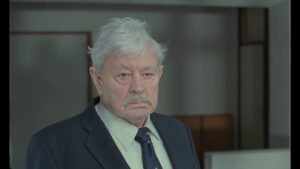
Deimantas Narkevičius. Stills from the film Revisiting Solaris, 2007
LB:
Since the mid-1990s, many contemporary artists have critically engaged with cinema’s history through practices such as appropriation, re-editing, and remixing. However, in Revisiting Solaris, your approach seems to be focused on evoking the presence of Solaris within a collective imaginary, rather than returning to existing images. Would you agree that your film explores Solaris’ enduring spectral place in the shared cinematic memory?
DN:
The imagery of Tarkovsky’s film is indeed enchanting, but I did not aim to directly use it in my work. Instead, I was drawn to the symbolism in his shots and the origins and interpretations of those images. This led me to M. K. Čiurlionis’ photographs, taken in Anapa, Russia, in the early twentieth century. I was interested in how the artist’s worldview influenced the Russian Symbolist movement of the time and how much of that artistic language shaped Tarkovsky’s film.
Tarkovsky effectively juxtaposes lush vegetation and the eerie tranquillity of the space station with the tumultuous ‘ocean’ glimpsed through the portholes. Across cultures, cosmogonic myths often emerge from oral traditions, tied to a voice revealing an otherworldly presence – such as the monolith in Stanley Kubrick’s 2001: A Space Odyssey. In contrast, Tarkovsky’s vision of cosmic consciousness as a floating ocean (specifically, the Black Sea’s surface as filmed in Anapa) offers a materialist interpretation. This ocean physically embodies human experiences, recreating them in tangible forms. The film’s ideology remains rationally grounded, portraying the fantastical as logically consistent.
Tarkovsky’s depiction of a non-religious cosmic consciousness that can resurrect the dead stimulates the imagination, even today.
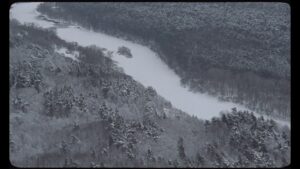
Deimantas Narkevičius. Stills from the film Revisiting Solaris, 2007
LB:
The film centres on the final chapter of Stanisław Lem’s novel – a chapter that Andrei Tarkovsky chose to leave unadapted in his 1972 film. What drew you to this particular part of Lem’s book, and how did it shape your own approach towards the story?
DN:
Tarkovsky’s loose adaptation of Lem’s novel fundamentally alters its message. In the film, astronaut Chris Kelvin experiences a miraculous encounter with a replica of his deceased wife aboard the space station. He returns to Earth, kneeling in a scene evocative of the prodigal son in Rembrandt’s painting, inviting religious, specifically Christian, interpretations. However, the camera’s zoom-out reveals this reunion occurs on the island of Solaris, deepening the ambiguity.
Meanwhile, Lem’s protagonist ventures directly to the conscious planet, landing on an island amidst its turbulent ocean, seeking to confront the mysterious phenomenon capable of manipulating his memories and emotions. Today, Lem’s narrative feels more visionary, resonating with current debates about artificial intelligence and its role in human relationships.
When I first saw Tarkovsky’s film 45 years ago, conversations about artificial intelligence and AI itself were far less prevalent. The novel’s exploration of memory and emotional manipulation by non-human intelligence directly speaks to contemporary polemics about AI’s increasing participation in our lives. Meanwhile, the New Age sensibilities in the film sparked discussions on spirituality and religiosity, particularly within the agnostic cultural context of the Soviet Union.
LB:
In a conceptually remarkable choice, you invited Donatas Banionis to reprise his role as Chris Kelvin decades later, adding a unique temporal dimension to Revisiting Solaris – one that speaks to the spectral quality of the film medium itself, especially knowing that Banionis has since passed away. What I find particularly intriguing is that you cast yourself in the film alongside Banionis, creating a scene in which he debates tone and expression with you. To me, this exchange subtly recalls Banionis’ own tensions with Tarkovsky, who famously clashed with him over his theatricality and wanted to reshape Banionis’ agency in the production process. Yet in Revisiting Solaris, it is now you, the film director, who is muted in conversation with Banionis. Furthermore, in the subsequent scene, your character is described as ‘an accountant, not a scientist’, echoing the same words used to address Kelvin in the book. What inspired you to step in front of the camera and engage in these filmic interactions, and what did you seek to convey through these reversals of the roles and positions?
DN:
One of the joys of video art is the freedom to improvise and experiment – both with the medium and the subject matter. From the mid- 1990s, I had been imagining a project involving Donatas Banionis reprising his iconic role, envisioning a collaboration that could reinterpret Solaris.
The idea of role reversals came naturally from Tarkovsky’s own narrative, which contains autobiographical elements. I thought: why not place myself and my family members alongside Chris Kelvin, as if preparing for a space journey? Kelvin visits his father, the closest person to him, before he leaves on a mission. As we see later in the film, empathetic connections are the basis of psychological balance, especially when reality begins to cast doubt on the authenticity of one’s own sensations.
In my scene with Donatas Banionis, the issue of the ethics of scientific research is discussed, but my questions are silenced, and Banionis’ answers are audible. So, before my supposed ‘mission’, I could not avoid the question of whether it is ethical at all to work with such a delicate and multi-layered work of cinematic art as Solaris. In this case, the motive of my short film experiment is to transfer at least some of the themes raised by Solaris to another era, another technological and cultural environment, without losing touch with the original.
In making Revisiting Solaris, I sought to incorporate Banionis’ reflections on his experience with Tarkovsky’s production. Interestingly, Banionis recalled not so much his discussions with Tarkovsky but rather his disputes with the cinematographer Vadim Yusov, who often directed his movements. Banionis joked that I was similarly demanding ‘mechanical’ actions, like walking in front of the camera – exactly what Yusov had insisted upon.
Despite such professional tensions, I believe the cameraman Audrius Kemežys and I succeeded in portraying Banionis’ sense of human loneliness, similar to what Tarkovsky achieved, albeit stemming from different causes. In 1972, these stemmed from differing acting traditions. Banionis, who had already appeared on stage as a teenager in pre-war Kaunas theatre, was adept at embodying dramatic characters with vivid intensity and remarkable physicality.
During our three-day shoot in early spring 2007, revisiting a collaboration that left a profound impression on me decades earlier, I couldn’t resist stepping in front of the camera to act alongside him, bringing moments of mutual reflection and dialogue.
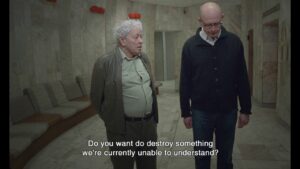
Deimantas Narkevičius. Stills from the film Revisiting Solaris, 2007
LB:
Revisiting Solaris includes scenes filmed in slightly worn Soviet-era locations, where the architecture suggests a modernism in decline. Were these architectural settings – remnants of a Soviet past that failed to fulfil its vision of the future – intended as a commentary on what was then, in the early 2000s, being discussed as the post-Cold War era, when the past itself seemed to shift in meaning?
DN:
Soviet-era architecture carries multiple layers of meaning, varying by generation. For some, it represents the aesthetic imposition of a colonial ideology intertwined with personal memories. For younger viewers, it can be appreciated for its radical architectural innovations, rooted in post-war European modernism. While utopian in its ambitions, this ‘traumatic modernisation’ is now often framed within colonial narratives, obscuring the bold artistic visions of individual buildings in broader critiques.
Having lived through that era, I have a personal connection to these spaces, recalling the excitement of newly opened landmarks of representative architecture, which, despite ideological constraints, reflected contemporary European styles. This internationalism stood out within the otherwise rigid public sphere of the Soviet Union. Of course, I am referring to the late period of the USSR, when the avant-garde examples of the 1920s had long since been relegated to museum shelves.
Filming in these worn interiors had a profound effect on Banionis, whose mood shifted visibly as he navigated spaces heavy with history. His silent yet expressive responses – ranging from curiosity to frustration – felt like an unspoken dialogue with the complicated period he had lived through.
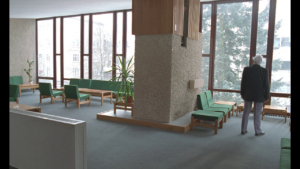
LB:
To represent Solaris, you used a series of early twentieth-century photographs by Lithuanian painter and composer M. K. Čiurlionis. What drew you to use Čiurlionis’ photographs, and how do you see their function within the complex temporality of the work?
DN:
I sought to deconstruct the sophisticated frames of Tarkovsky’s Solaris, where the influence of classical painting compositions is unmistakable. The early twentieth-century photographs by M. K. Čiurlionis, depicting the Black Sea coast, resonated strongly with Tarkovsky’s portrayal of Solaris’ ocean – filmed in the same Anapa region almost seven decades later.
Incidentally, these photographs also evoke Lem’s description of the ‘mimoid’, where remnants of past civilisations resurface within a sentient, undulating mass. In Čiurlionis’ images, anthropomorphic shapes emerge naturally – mountains, waves, a solitary boat, or a small human figure against a vast, otherworldly landscape. These documented landscapes feel both grounded and ethereal, akin to sketches of his larger painterly visions.

Waves crashing into jetty, 1905, photograph by M. K. Čiurlionis
LB:
In Solaris, the alien ocean generates simulacra-like entities from the characters’ memories, raising questions about the authenticity of one’s perception and consciousness. Do you think that Lem’s exploration of this topic is becoming even more relevant today, in times often described as ‘post-truth’, with growing debates around artificial intelligence and its ability to ‘simulate’ reality?
DN:
In the late 1970s, while still at school, I was struck by this science fiction film in which so much of the futuristic content is conveyed through silence, subtle sound, and moderate dialogue. It goes far beyond the genre-typical expansion of earthly mechanisms into unknown spaces and planets, thereby dressing colonialism in the garb of future exploration. Although it greatly disturbs the imagination, the authenticity of sensations, when faced with images or even repetitions of people generated by an unknown intelligence in this film, falls into the uncertainty of creating a vision of the future. It is a metaphor created as an artistic interpretation by the director.
While collecting material for my film, I came across an excerpt from an interview given by Stanisław Lem to Polish television in the year 2000. In it, he discusses the possibilities artificial intelligence offers and the difficulties it poses for human relationships. This, in his story, is also presented as an artistic metaphor, even though the term ‘artificial intelligence’ is not explicitly used. Above the illuminators of the space station hangs a planet, a physical body, in which an ocean of ‘consciousness’ teems. In the context of Tarkovsky’s film, the appearance of human copies presupposes the divine promise of resurrection – a promise that, as we see, has already been disrupted by human scientific activity. I was very impressed at the time that both artists defended this divine possibility of resurrection through stylish artistic metaphors. At least for myself, in discussing the film’s visual expression, I wanted to incorporate other visual materials that were produced much earlier in the same location – Anapa. In those photographs by Čiurlionis, one can notice hints of cosmic visions permeating the earthly landscape.
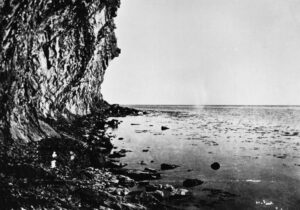
Seacoast, 1905, photograph by M. K. Čiurlionis
Lem, in writing the novel, apparently formulated this question from an ethical position, just as you ask about the already-occurring human invasion, which has disrupted trust in the authenticity of our sensations and in what we could still call reality. In that context, I would like to quote an episode from Lem’s interview, where he addresses intelligent machines:
Recently, I read in the daily newspaper Gazeta Wyborcza that artificial electronic intelligence will appear very soon. This is not true. It will not appear. Even more accurate imitations will appear, which will correspond to the computer that matched Kasparov. Certain acts of human activity or production will be able to be reduced to certain elementary schemes – not necessarily recurring paradigms. This can be done: to implement the so-called Turing test. An electronic machine, today called a computer, will be able to pretend to have intelligence and to be a conscious partner of the interlocutor-human. This will not be a deception, but an imitation.
Repeated fictitious actions, imitation of the human voice – all this can be easily produced and created as if in mirage situations, where it will seem to an ordinary, or perhaps even a sufficiently educated person, that they have encountered an intelligent partner. But in reality, it will behave like a tennis player playing against a wall – the ball bounces, and the player, as far as possible, tries to catch it in the middle of the racket. It may seem to such a tennis player that he has a partner. But the mirage situations will not be as tangible as the wall. The illusion can be perfect.
I also received from Der Spiegel – let’s call it brutal – an offer, thickly covered in dollar sauce, to write something about the future, from which the non-electronic present will be viewed with a certain indulgence. I thought that virtual reality, which I called fantomatics, could lead to experiencing such things that we do not experience in reality. Virtual reality will develop in such a way that it will be increasingly difficult to distinguish it from ordinary reality.
At present, we do not know of any methods that could help to weaken the universally flourishing power of electronic visual processes. However, I am sure that they cannot completely eliminate our thinking, based on the Gutenberg galaxy, because it is impossible to effectively transfer thought to an image. If this happens, it will be a very rare case.
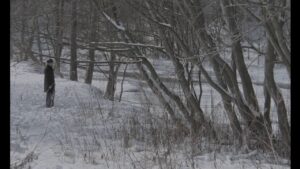
LB:
You recently completed your first feature-length 3D film, Twittering Soul (2023), which is now screening at film festivals worldwide, marking an expansion of your moving image work into the world of cinema. To close, I would love to hear your thoughts on the potentials you find in cinema. Do you feel that at the moment cinema offers something especially compelling for expressing the themes and subjects you wish to explore?
DN:
For several decades, video artists have been presenting their works in art exhibitions, giving them the properties of objecthood. Combinations of several projections are set; objects or special architectural solutions are introduced in order to create a third dimension to an essentially flat moving image. For many decades, this was based on a critical position towards single-channel commercial cinema and television broadcasts. I no longer see the effectiveness of this ideological paradigm with the advent of networked electronic dissemination tools.
The plot of the film Twittering Soul is set at the very end of the nineteenth century, just before the invention of the film camera. At that time, stereoscopic photography was flourishing, having already transferred the documentary image to a physical 3D state. This anachronistic technology constantly returns to the practices of cinema and photography at different periods, with ever-newer powers of suggestion. It will probably never be easy to evoke the kind of impact the first film screenings had, when the audience ran out of the theatre at the sight of a train arriving at La Ciotat station. However, the charm of the stereoscopic medium restores depth to the film frame, as if in a multi-dimensional art installation. Only in this case, this can be experienced in a cinema, with greater technological impact, involving different audiences and slightly different traditions of image-making than those used in art museums.
Although filmgoers are more accustomed to having their attention completely captured by images and sounds, they are also more open to what I would call the wonder – or simply the surprise – of what they see on the screen. In the case of my film, the relevance is to how the audience receives the esoteric content They are more forgiving of visible spells and audible incantations. They are more suggestively presented with a stereoscopic image of the landscape, which recreates the charm of material, archaic plains that have changed little since the Ice Age and have survived in the very geographical centre of Europe. Ultimately, this is a historical limit: how the Lithuanian landscape and wooden urbanism appeared at the emergence of cinematography and, later, at the advent of fossil-fuel-powered machines, which left today’s unresolved economic, ecological, and geopolitical tensions. However, the feeling of a three-dimensional image restores a certain impression of the cinematographic experience. It can simply be admired again when the image demands greater neural work on the retina and the developing story is experienced less linearly. In each scene, there is something to ‘look at’, as the images are presented like moving characters in architectural models or in the dioramas of the nineteenth century. The characters exist in a more harmonious relationship with nature, on which they depend both materially and mentally.
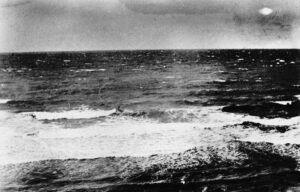
The sea, 1905, photograph by M. K. Čiurlionis
Deimantas Narkevičius is a distinguished artist and filmmaker whose work delves into the intersections of personal memory and political history, particularly within post-Soviet contexts. Trained as a sculptor at the Vilnius Academy of Arts, he later transitioned to film and video, employing documentary techniques to examine how personal memories relate to political histories. His work has been widely shown at major contemporary art institutions and events, including Centre Pompidou, Paris; Museo Nacional Centro De Arte Reina Sofia, Madrid; Tate Modern, London; Museum of Modern Art, New York; Stedelijk Museum, Amsterdam; the 49th and 50th Venice Biennales, and Manifesta II and X. In 2008, Narkevičius received the Vincent Award and the Lithuanian National Prize for Culture and Arts. In 2017, the National Gallery of Art in Vilnius held a major retrospective of his work. More recently, in 2022, his solo exhibition ‘Anachronisms’ was showcased at Konschthal Esch in Luxembourg. In 2024, he presented ‘The Fifer’ at Maureen Paley in London, featuring a series of enlarged Polaroid prints depicting mythological stones in Lithuania.
Lukas Brasiskis is the Curator of Film and Video at e-flux. He was a co-curator of the 14th Shanghai Biennale (2023–24) and is one of the three Artistic Directors of the upcoming Seoul Media City Biennale (2025). After receiving his PhD degree in Cinema Studies from New York University in 2022, he has taught courses at Columbia University and Brooklyn College/CUNY. His writing on moving image is widely published, and most recently he was the co-editor of Cinema and the Environment in Eastern Europe (Berghahn Press, 2024) and Jonas Mekas: The Camera Was Always Running (Yale University Press, 2022). Since 2024, he has been a co-editor of e-flux’s weekly publication Film Notes.


